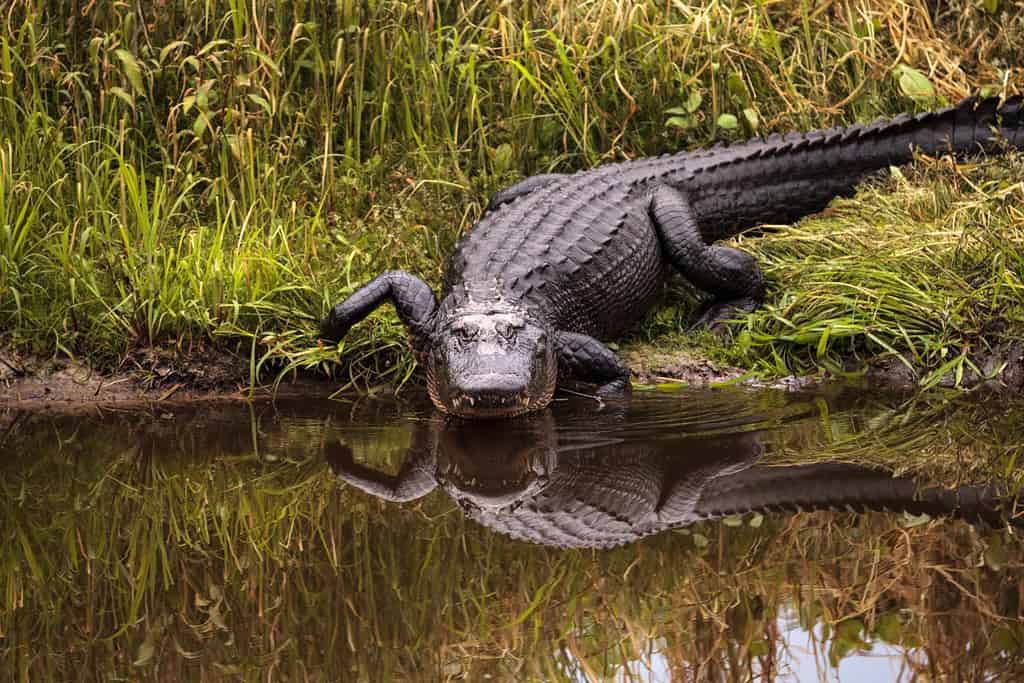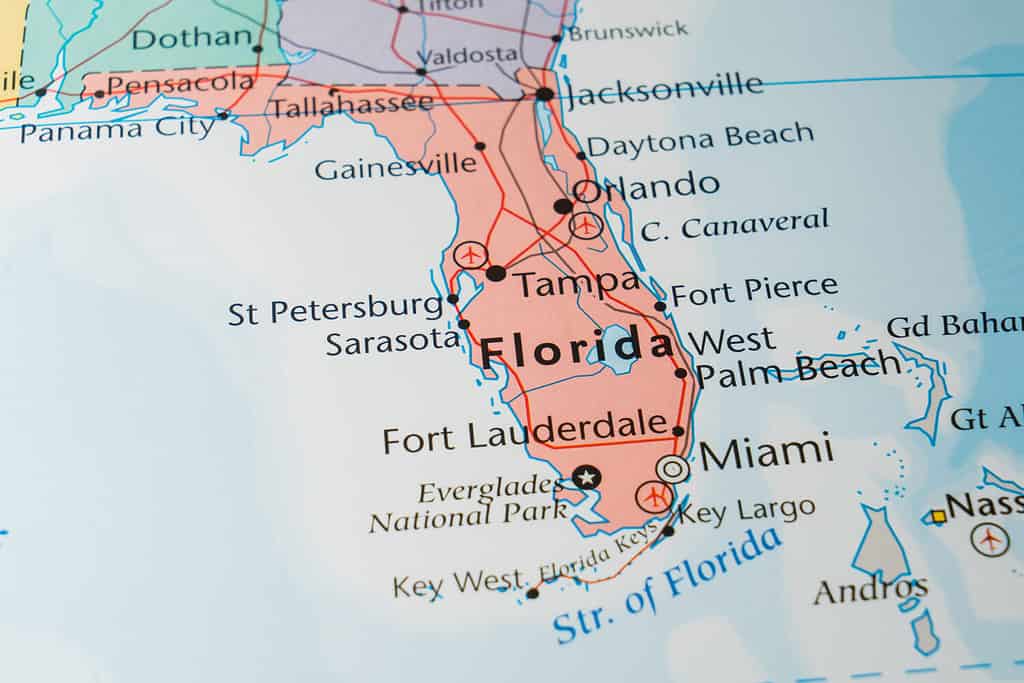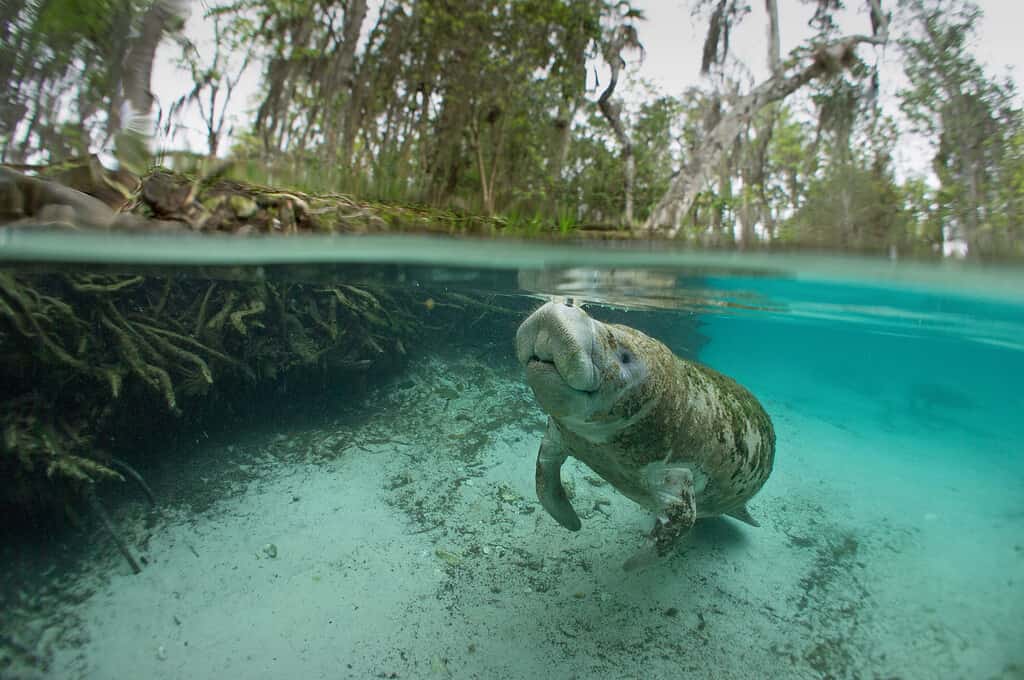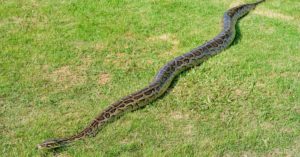When we look at the world as a whole, we know that about 70% of the Earth is covered in water. That’s a lot of water, and that’s a lot of animals that can reside in those waters. If we drain this down to just the state of Florida, approximately 18.5% of this state is covered in water.
This leaves room for a lot of alligators to be able to find a home, especially in one of Florida’s most famous rivers, the Crystal River. However, before we can get to that, we need to dive into more about the alligators and just how many there are in the state of Florida.
Alligator (Alligator mississippiensis) Facts

Alligators can live up to 60 years in the wild.
©SunflowerMomma/Shutterstock.com
Two recognized species in the Alligatoridae family are referred to as alligators: the American alligator and the Chinese alligator. The alligator residing in the United States is the American alligator (Alligator mississippiensis), and they are of the order Crocodilia.
Alligator Physical Characteristics
Alligators are large reptiles that can weigh anywhere from 181-363 kilograms (400-800 pounds). They can reach incredible lengths of 2.5-4.5 meters (8-15 feet) in length. However, there are always exceptions to the rule. In Arkansas, a massive alligator weighed 1,380 pounds. Then, in Louisiana, an alligator was caught that was 19.2 feet in length.
Alligators also have incredible jaws that have a tremendous bite force with their 80 teeth. Now, there is conflicting research out there that states that the American alligator has about a 2,000+ PSI bite force range, which is incredibly impressive and about four times more than that of a lion. However, some more in-depth research by our A-Z Animals team leads to studies that show the range is more like 3,000-4,000 PSI.
In addition to their fierce bite force, the American alligator also has a one-inch thick skin that is a layer of scales. These scales are often referred to as their armor. With this thickness of skin, their bite force and their size make them an unstoppable force. So, let’s just see how many of these large reptile giants live in Florida.
How Many Alligators Are There in Florida?

Florida is approximately 65,758 square miles.
©Alexander Lukatskiy/Shutterstock.com
The American alligator resides in Asia and North America. Their population is estimated to be about four million. The conservation status of the American alligator is of the least concern. They are not in danger of going extinct.
Of the four million, Florida takes second place in the U.S. for the state with the most alligators. Louisiana takes first place with about two million alligators. Florida comes in second with about 1.3 million alligators.
According to the Florida Fish and Wildlife Conservation Commission (FWC), “Alligators have inhabited Florida’s marshes, swamps, rivers and lakes for many centuries, and are found in all 67 counties.”
Now, this brings us to Florida’s Crystal River in Citrus County. Let’s see if there are any alligators there!
Are There Alligators in Florida’s Crystal River?

The Crystal River is famous for having manatees.
©tobiasfrei/iStock via Getty Images
With over one million alligators in the state of Florida, and as the FWC states, there are alligators found in all 67 counties; yes, there are alligators that reside in the Cyrstal River.
“In Crystal River, you may find alligators sunning themselves on logs and other dry-land areas.” the Crystal River Sports Fishing adds.
There are even reports of sightings of alligators by those who were swimming in the Crystal River. One such case was back in 2017 when a group went out snorkeling, and an alligator approached them.
“It was just my group and I, snorkeling around Pretty Sister, and I’m taking pictures and videos of them and the spring when I see something swimming towards me,” Ellis told FOX 13 News. “I was confused at first because I have never [saw] an alligator in there before, and it didn’t look like any manatee or turtle I’d ever seen!”
Another such case was in 2021 when a concerned citizen saw alligators in the Crystal River’s Copeland Park. For the safety of residents, children, and families that go to this community park, the FWC issued a permit to have a trapper go and remove three alligators.
This, of course, begs the question if alligators that are in the Crystal River are dangerous.
Are Alligators in Florida’s Crystal River Dangerous?
To put it quite bluntly, most alligators will not attack humans. However, we must preface this by saying that just because it is rare does not mean it does not happen. Alligators are wild animals, and wild animals cannot be predictable.
The FWC takes the threat of “nuisance alligators” very seriously. “The FWC places the highest priority on public safety and administers a Statewide Nuisance Alligator Program (SNAP). The goal of SNAP is to proactively address alligator threats in developed areas. They are also conserving alligators in areas where they naturally occur.”
In the rare instance that you are approached by an alligator, and it is coming toward you, the best thing you can do is to back away slowly and not make any sudden movements. Alligators are known to be able to run up to short distances at 35 miles per hour. So, unless you can run 36 miles per hour, we would not suggest running.
The photo featured at the top of this post is © Danita Delimont/Shutterstock.com
Thank you for reading! Have some feedback for us? Contact the AZ Animals editorial team.







